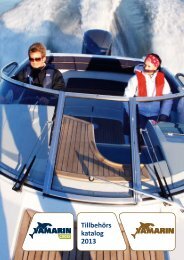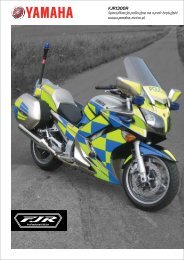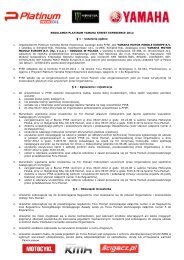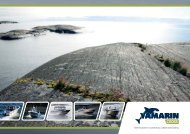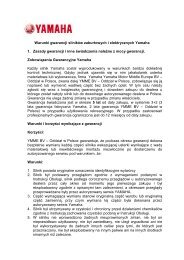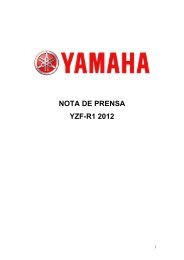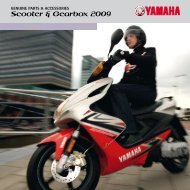2000 model Yamaha YZ426F Motocrosser - Yamaha Motor Europe
2000 model Yamaha YZ426F Motocrosser - Yamaha Motor Europe
2000 model Yamaha YZ426F Motocrosser - Yamaha Motor Europe
You also want an ePaper? Increase the reach of your titles
YUMPU automatically turns print PDFs into web optimized ePapers that Google loves.
<strong>2000</strong> <strong>model</strong> <strong>Yamaha</strong> <strong>YZ426F</strong> <strong>Motocrosser</strong>IntroductionWhen <strong>Yamaha</strong> launched the original YZ400F 4-stroke motocross machine it astoundedthe entire dirt bike world. Until then the typical 4-stroke motocrosser was a large capacityheavyweight ‘thumper’ that appealed to a minority of riders.The YZ400F changed all that overnight!Looking, sounding and performing like no other 4-stroke dirt bike, the ground-breakingYZ400F was constructed using a free-revving, highly compact engine housed in a lightand agile 250-class chassis.This winning formula has proved itself to be a great success at all levels in the last fewseasons. In the 500cc Motocross World Championship series, <strong>Yamaha</strong>’s factory bikeshave stormed to many GP wins since their debut race in early 1997 – while Doug Henry’shistoric win on his YZ400F in Las Vegas two seasons ago was the first time that a 4-stroke had won a US Supercross round.In 1998, YZ400F-mounted Henry went on to win the AMA 250 Motocross title, and after5 rounds of the ‘99 500cc Motocross World Championship season, <strong>Yamaha</strong> YZ400Ffactory riders Andrea Bartolini and Alessandro Puzar are placed 1st and 4th overallrespectively. Currently there are four <strong>Yamaha</strong> riders in the top 10 of the World 500ccChampionship, with privateers Francisco Garcia Vico lying 8th, and Miska Aaltonen10th – an impressive statistic that underlines the great impact that the YZ400F is havingat GP level.Not only has the <strong>Yamaha</strong> YZ 4-stroke proved that it can beat the best 4-strokes in theworld – its US Supercross and AMA 250 Championship victories demonstrate beyondany doubt that in the right hands the YZ400F can beat the world’s best 250 2-strokes!In just two years the <strong>Yamaha</strong> YZ400F has made a massive impact on the world ofmotocross from privateer through to World Championship level. Now, for the <strong>2000</strong>season, <strong>Yamaha</strong> are to launch the <strong>YZ426F</strong>, a second generation 4-stroke motocrossmachine that features a larger capacity powerplant as well as an extensive range of engineand chassis upgrades developed directly from our GP-winning factory bikes.<strong>Yamaha</strong> <strong>YZ426F</strong> Engine ProfileBigger bore, larger capacityFor the new race season the YZF 4-stroke gets a highly modified bigger-bore enginewhich, as the name illustrates, now displaces 426cc. This has been achieved by increasingthe bore from 92mm diameter to 95mm diameter, while the short 60.1mm stroke remainsunchanged. The net result is an engine that delivers more low to mid range power, whileat the same time retaining its free-revving character that has made this one of the mostcompetitive machines – 4-stroke or 2-stroke – in today’s MX scene.New internal componentsAlso new for <strong>2000</strong> is a 19mm diameter piston pin, 1mm larger than the ‘99 design, aswell as a modified connecting rod running with a beefed-up big end bearing whose widthis increased by 1mm to 16.8mm. And for reduced vibration and enhanced engineresponse the crankshaft design is modified and now features a reshaped web.Redesigned Keihin FCR carburettor
Another important change for next season is the fitment of a new Keihin FCR carburettorwhich is designed to offer even better throttle response in a range of conditions. This newcarburettor now features an integral red-coloured hot start knob situated next to the blackcolouredcold start knob, unlike the ‘99 <strong>model</strong> whose hot start knob was mountedremotely. Another change on the intake for <strong>2000</strong> is the use of a lighter resin joint betweenthe carburettor and air box which replaces the previous aluminium component.New heavy-duty clutchTo handle the new <strong>YZ426F</strong>’s increased low to mid range torque output the machine isequipped with an uprated clutch. Friction plate diameter is increased from 148mm to155mm for the <strong>2000</strong> <strong>model</strong>, and the number of clutch plates goes up from 7 to 8. Toaccommodate the new heavy-duty clutch the bike’s right-side engine case is redesignedand now features a 157mm diameter cover.Revised 1st and 2nd gear ratiosSignificant changes have also been made to the YZF’s compact transmission, and thelatest <strong>model</strong> now runs with revised 1st and 2nd gear ratios for improved accelerationperformance. <strong>Yamaha</strong>’s engineers have also enhanced the shift feel and speed by the useof additional chamfering on various gears.Enhanced cooling efficiencySpecial attention has been paid to the cooling system on the new big-bore engine, and the<strong>YZ426F</strong>’s increased power output will be matched by the fitment of new larger-capacityradiators. Similar to the system used on the WR400F enduro machine, the new radiatorsare 10mm wider at 121.8mm, and incorporate 11 core tubes each – 1 more than the 1999<strong>model</strong>. Supplied in bare, unpainted aluminium, they improve the cooling efficiency of thenew YZF for consistent performance throughout the longest race.Free-flowing silencerThe final engine modification is the use of a new free-flowing silencer which nowemploys a larger-diameter 50.8mm pipe feeding the muffler – a design that enables thenew larger-capacity engine to achieve higher levels of performance across the rpm range.Modified CDI and smaller CDI rotorThe new <strong>YZ426F</strong> is also equipped with a modified CDI designed to offer enhancedthrottle response, and the diameter of the CDI rotor comes down from 98mm to only83mm for reduced weight and instantaneous pick-up.<strong>YZ426F</strong> EngineTechnical Highlights• Increased capacity of 426cc• Bigger bore of 95mm (1999=92mm)• Uprated connecting rod, piston pin and big end• New low-vibration crankshaft• New FCR carburettor with integral hot start button• New resin joint between carburettor/air filter box• Larger 155mm diameter clutch with 8 clutch plates• New right side engine case• Revised 1st and 2nd gears• Smoother shifting transmission• New larger capacity radiators
• Free-flowing big-bore silencer• New CDI• Smaller diameter CDI rotor<strong>Yamaha</strong> <strong>YZ426F</strong> Chassis ProfileWhen the YZ400F production machine was first launched for the 1998 season its 250-class chassis made it the most compact production 4-stroke motocrosser evermanufactured. For the <strong>2000</strong> season our designers have not only produced a higher-torquebig-bore powerplant – they have also succeeded in creating an even more agile handlingpackage whose total engine and chassis performance has the potential to defeat anyexisting motocrosser.New high-tensile steel frame<strong>YZ426F</strong>’s new main frame is manufactured from stronger HT-780 steel tubing whichutilises new-technology brazing in its construction to create a lighter and more rigidassembly that ensures precision handling performance. In addition to the use of highertensile steel tubing the <strong>2000</strong> frame features a relocated head pipe which is moved back togive a compact 1490mm wheelbase, 5mm less than in ‘99. And for further weight savingsthe new chassis is equipped with a fully detachable aluminium subframe.Uprated front forks<strong>Yamaha</strong>’s suspension has always been regarded as being one of the best originalequipment systems in today’s MX scene, and to ensure that things stay that way we havemade a number of important modifications to the design of the upside down front forksfor <strong>2000</strong>.For even more responsive characteristics the new <strong>YZ426F</strong> runs with lightweightaluminium piston rods instead of the steel components featured last season. And forsmoother suspension action – especially over less severe terrain – new anti-stiction dustseals are fitted and the internal faces of the outer tubes have a new low friction treatment.All-new triple clampsBoth the triple clamps have also come under close scrutiny by our engineering teamduring the last season. To increase front end rigidity for precision steering the thicknessof the lower clamp where it grips the fork tube has been increased by 5mm to 45mm deep– and the underside of the lower triple clamp now features an extra strengthening rib.Also modified is the upper triple clamp, where the handlebar mounting brackets havebeen shifted forwards by 10mm so that the centreline of the ‘bars now sits 5mm in frontof the steering pipe’s centre – a move designed to allow the rider to get more weight overthe front end in tight corners.With the exception of spring rates and settings the <strong>2000</strong> <strong>YZ426F</strong> forks are the same asthose fitted to the latest YZ250 and YZ125.Lightweight rear suspensionLike the <strong>YZ426F</strong>’s new front forks the latest <strong>model</strong>’s rear shock is also featured on the<strong>2000</strong> <strong>model</strong> YZ250 and YZ125.As with the front forks we have looked at ways of saving weight, and in the case of therear shock this has been achieved by replacing the ‘99 <strong>model</strong>’s steel damper rod bearingwith an aluminium component. And for easier suspension tuning a new-style andredesigned compression damping adjuster is fitted.Improved controls



